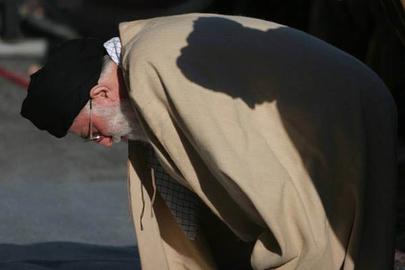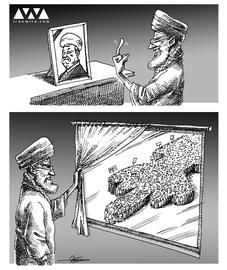“All constitutions of the world are changed after a while and we must do the same.” The media quoted Ayatollah Akbar Hashemi Rafsanjani as saying this just a week ago. But the dream is over now, at least for him.
A change in the constitution, however, is not the only development that could possibly emerge in the post-Rafsanjani era. Could Rafsanjani’s plans to reform how Iran is governed get underway? How will President Rouhani fare in the election later this year? And could the Green Movement leaders finally be freed? We look at some of the most important changes that could follow the death of one of Iran’s most influential figures.
1. Transforming the supreme leadership
Akbar Hashemi Rafsanjani was well known for his assertion that, in the near future, the Islamic Republic should be led by a supreme council, and not a single individual — though in the early days of the republic, he denied having this opinion. He did not often give public statements on the topic, but on the few occasions he did speak about it, he claimed the current supreme leader, Ayatollah Ali Khamenei, had himself agreed with the idea in 1989, the year he took over as leader after the death of Ayatollah Khomeini. Some Rafsanjani critics have dismissed the idea as amounting to “sedition,” and Khamenei has stayed quiet on the subject — there is certainly nothing in his speeches to suggest he supports the idea.
2. Term Limit for the Leader
Rafsanjani also once claimed that Khamenei approved the idea of a time limit on the office of the supreme leader. “A term limit could have been implemented in the constitution,” he said, “and many believed that we should do it.” But he went on to say he did not think it was necessarily an “important issue” and explained that “to do it, the constitution must change,” adding, “this is not a change that the Assembly of Experts can decide on.”
In the early winter of 2015, Karimi Ghoddousi, a member of parliament, reported that Hashemi Rafsanjani did want to introduce a term limit for the office of the supreme leader, and there were other similar claims.
The idea of limiting the term of the leadership to, say, a period of 10 years, is a debate that goes back to the 1980s. Opponents believe that a limit is contrary to the commitment to pledge allegiance to the “Guardianship of the Islamic Jurist,” the founding principle of the Islamic Republic, and they have spoken out against it with strong conviction. Nonetheless, reports that Khamenei is not hostile to the idea continue to emerge. If Khamenei approves it, the office of the leadership of the Islamic Republic could be limited to 10 years.
3. Changes in Policies
The regime’s macro-policies are subject to approval by the Expediency Council. These include initiatives such as supporting local producers, combating inflation and reducing unemployment. Recently, in a meeting with Hashemi Rafsanjani, Ayatollah Khamenei talked about the possibility of revising some of these policies. At the time of his death, Rafsanjani was the president of the Expediency Council, and there will be a period of waiting until his successor is selected. The political tendencies of this successor will play an important role in how these policies might change. And although these changes might not have huge significance in the overall political landscape, whether or not they happen will offer some guidance to understanding the supreme leader’s outlook — for example, how he views moves toward reducing the country's defense capabilities.
4. Election of Khamenei’s Successor
Electing Khamenei’s successor is one of the most important decisions Iran’s regime will make in in the near future. Hashemi Rafsanjani’s absence in this process will be noted, although in reality, due to the decline in his influence in recent years, he would not have had much of a say.
There are rumors that Ebrahim Raeesi is being considered for this position. Raeesi was the Attorney-General of Iran from 2014 to 2016 and is now the custodian of Astan Quds Razavi, the biggest religious endowment in Iran and a major player in Iran’s economy.
The Assembly of Experts, which is in charge of selecting the supreme leader, has been discussing the question of Khamenei’s successor for years, and has assigned a special committee to deal with the task. The committee must work according to articles 107-109 of the Iranian constitution, which specify the qualifications for the leader. In the previous Assembly of Experts, Mohammad Yazdi, the assembly’s current chairman, was also head of this committee. According to Hashemi Rafsanjani, he refused to divulge any of the names of the people the committee was considering for future leadership. The head of the committee is now Mohammad Momen, a figure with very close ties to Ayatollah Khamenei.
The sudden death of Rafsanjani is bound to heighten the feeling of urgency to find a successor to Khamenei.
5. Changes in the Constitution
On January 1, Rafsanjani raised the issue of changing the constitution. This differed from what he said in an interview in 2012. Then he said the time was not right. But it would appear that certain events over the last four years convinced him that the time for change had finally arrived. The constitution was last amended in 1989.
If the constitution is changed soon, it might be altered in ways Khamenei and the hardliners want — and not in the way Rafsanjani had in mind.
6. Adopting the Parliamentary System
In 2011, Ayatollah Khamenei talked about changing the the Islamic Republic’s presidential system back to a parliamentary one, drawing much attention in the media and in political circles. Khamenei said that such a change could take place “in perhaps a distant future,” although the switch back could have been instigated over the last five years, especially with support from influential figures including parliament’s speaker Ali Larijani.
Rafsanjani disagreed with this idea and believed that it would damage the republican aspect of the Islamic Republic. “The current system, meaning the presidential system, is better,” he said.
7. Restored Relations With the US
Rafsanjani was a proponent of restoring relations with the United States, and during Khomeini’s time he tried to open communication channels with America. The most famous attempt became known as the Iran-Contra Affair, which was a major scandal in the US and created extensive political tensions in Iran.
At the moment, the prospects of further restoring relations with the United States are not promising, and Ayatollah Khamenei has not shown any interest in untangling this knot.
8. The Presidency of Hassan Rouhani
Many have warned that the death of Hashemi Rafsanjani may seriously damage the prospects of Rouhani’s re-election as president of the Islamic republic. It cannot be denied that Rafsanjani’s death is a big loss for Rouhani.
Rouhani’s re-election in the forthcoming presidential election is a very critical matter. It would give him a chance to establish his role as the successor to Rafsanjani and safeguard the position of Iran’s moderates and reformists. His loss could be a lethal blow to them and could even put an end to Rafsanjani’s ideas for reshaping the top structure of the Islamic Republic.
9. Ending House Arrests
Ending the house arrests of Green Movement leaders Mir Hossein Mousavi and Mehdi Karroubi was one of the most important items on Rafsanjani’s agenda. He even claimed that he had almost succeeded but that interventions from others had prevented it.
If the house arrests of these two political figures came to an end, it could open the way for significant changes in both Iranian politics and the reformist camp. But at this moment there is little prospect of that happening.
visit the accountability section
In this section of Iran Wire, you can contact the officials and launch your campaign for various problems
























comments